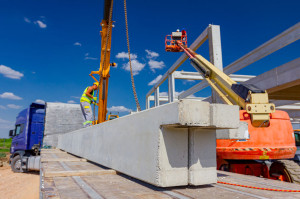 Two concrete construction methods are significantly changing the building world: pre-cast concrete and insulated concrete forms (ICF). These concrete building options have unique advantages and disadvantages, especially in today’s construction landscape. Project timelines are faster than ever, focusing more on reducing environmental impacts, improving building durability, and reducing costs.
Two concrete construction methods are significantly changing the building world: pre-cast concrete and insulated concrete forms (ICF). These concrete building options have unique advantages and disadvantages, especially in today’s construction landscape. Project timelines are faster than ever, focusing more on reducing environmental impacts, improving building durability, and reducing costs.
In this blog, we’ll explore the advantages and disadvantages of these concrete forms and how they’re used in projects today.
Traditional concrete is created by pouring cement over rebar support and allowing it to dry, and this method has served the construction world for years. However, the labor-intensive nature of pouring concrete and the challenges of forming structures onsite have driven the demand for innovative alternatives like ICF and pre-cast concrete. Pre-cast and ICF concrete have simplified the use of concrete in building projects today.
The advantages/disadvantages of pre-cast concrete forms
Pre-cast concrete forms have many advantages, especially compared to traditional concrete. Since these forms are assembled off-site at pre-cast concrete plants, they can be precisely constructed, which allows for more design versatility. Some other benefits of pre-cast concrete include:
- Less labor-intensive onsite work: Since the pre-cast pieces are prepared off-site, they can arrive at the job site ready to be installed, reducing project timelines and costs.
- Increased durability: Pre-cast concrete forms are built with more internal support because they must withstand travel to the job site and the installation process.
- Reduced labor costs: Using pre-cast concrete materials can reduce the labor needed on the job site and overall labor costs.
Pre-cast concrete has a lot of benefits, and it’s becoming increasingly used in more projects every day. But there are some disadvantages to using pre-cast concrete, including:
- Logistical challenges: Transporting large, heavy pre-cast concrete forms to the job site can be highly specialized, especially over long distances. Large forms may require specialized travel permits or escort vehicles, which can be challenging to organize and expensive.
- Installation issues: Most large and heavy pre-cast concrete forms require cranes or heavy machinery to install, and misalignment or joint problems are common. Working with pre-cast concrete forms requires specialized expertise to ensure they’re installed correctly.
- Modification difficulties: Altering or changing pre-cast concrete forms during the building process is also more challenging, as cutting through panels or removing sections can compromise the forms’ structural integrity.
Is ICF the better choice?
Like pre-cast concrete, ICF is assembled off-site to fit the design specifications and delivered for installation. However, the unique nature of how ICF is created gives it some extra benefits. ICF forms are built using expanded polystyrene (EPS) foam, which is lightweight and offers excellent insulation benefits. This foam is molded into hollow blocks or panels with interlocking edges, like sophisticated Lego blocks. The ICF blocks or panels are assembled onsite, and rebar is inserted into the hollow cavities before concrete is poured into the space between the foam panels. This process creates a solid concrete wall encased in EPS foam for added durability, insulation, mold resistance, and thermal efficiency. You can add exterior and interior finishes to the foam, like stucco, siding, or drywall.
Like pre-cast concrete, many of the disadvantages of ICF concrete remain the same. They are built off-site, require specialized installation, and are more expensive. However, the benefits of the added EPS foam insulation make ICF a very appealing choice in construction projects today. ICF forms can extend the life of a building with their increased durability, moisture resistance, and energy efficiency. Even though the upfront cost of using ICF may be more expensive over a building’s lifetime, the price may be worth it.
Project Spotlight: 21 & View
Integrating pre-cast concrete and ICF is becoming increasingly common in construction projects. We did this on one of our past projects, the 21 & View project in Salt Lake City, Utah, a luxury residential building featuring 29 units, two commercial spaces, and covered parking. For this project, we utilized both ICF for the two-story concrete building structure and pre-cast concrete for the floors. This combination provided the building with enhanced stability and streamlined the construction process, showcasing the benefits of using both materials.
Ultimately, there is no definitive winner between pre-cast concrete and ICF; each material has unique strengths suited to various construction needs. Our experience with both methods reveals that combining pre-cast concrete and ICF in your design plan often yields the best results. As you plan your next development project, consider consulting our team for tailored recommendations that align with your design specifications. By embracing these innovative concrete construction methods, you can achieve greater efficiency, durability, and energy savings in your building projects.








